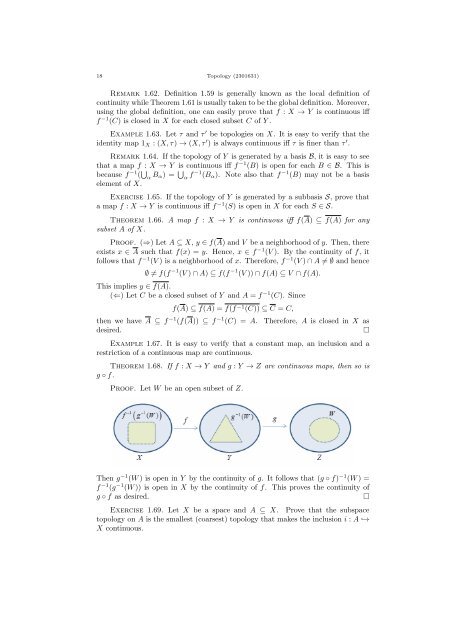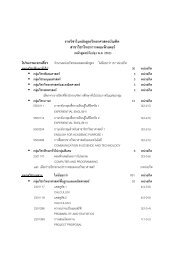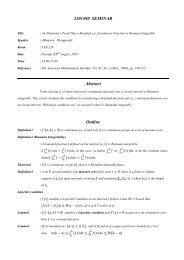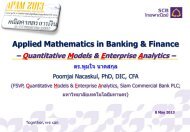Lecture Notes Topology (2301631) Phichet Chaoha Department of ...
Lecture Notes Topology (2301631) Phichet Chaoha Department of ...
Lecture Notes Topology (2301631) Phichet Chaoha Department of ...
Create successful ePaper yourself
Turn your PDF publications into a flip-book with our unique Google optimized e-Paper software.
18 <strong>Topology</strong> (<strong>2301631</strong>)<br />
Remark 1.62. Definition 1.59 is generally known as the local definition <strong>of</strong><br />
continuity while Theorem 1.61 is usually taken to be the global definition. Moreover,<br />
using the global definition, one can easily prove that f : X → Y is continuous iff<br />
f −1 (C) is closed in X for each closed subset C <strong>of</strong> Y .<br />
Example 1.63. Let τ and τ ′ be topologies on X. It is easy to verify that the<br />
identity map 1 X : (X, τ) → (X, τ ′ ) is always continuous iff τ is finer than τ ′ .<br />
Remark 1.64. If the topology <strong>of</strong> Y is generated by a basis B, it is easy to see<br />
that a map f : X → Y is continuous iff f −1 (B) is open for each B ∈ B. This is<br />
because f −1 ( ∪ α B α) = ∪ α f −1 (B α ). Note also that f −1 (B) may not be a basis<br />
element <strong>of</strong> X.<br />
Exercise 1.65. If the topology <strong>of</strong> Y is generated by a subbasis S, prove that<br />
a map f : X → Y is continuous iff f −1 (S) is open in X for each S ∈ S.<br />
Theorem 1.66. A map f : X → Y is continuous iff f(A) ⊆ f(A) for any<br />
subset A <strong>of</strong> X.<br />
Pro<strong>of</strong>. (⇒) Let A ⊆ X, y ∈ f(A) and V be a neighborhood <strong>of</strong> y. Then, there<br />
exists x ∈ A such that f(x) = y. Hence, x ∈ f −1 (V ). By the continuity <strong>of</strong> f, it<br />
follows that f −1 (V ) is a neighborhood <strong>of</strong> x. Therefore, f −1 (V ) ∩ A ≠ ∅ and hence<br />
∅ ̸= f(f −1 (V ) ∩ A) ⊆ f(f −1 (V )) ∩ f(A) ⊆ V ∩ f(A).<br />
This implies y ∈ f(A).<br />
(⇐) Let C be a closed subset <strong>of</strong> Y and A = f −1 (C). Since<br />
f(A) ⊆ f(A) = f(f −1 (C)) ⊆ C = C,<br />
then we have A ⊆ f −1 (f(A)) ⊆ f −1 (C) = A.<br />
desired.<br />
Therefore, A is closed in X as<br />
□<br />
Example 1.67. It is easy to verify that a constant map, an inclusion and a<br />
restriction <strong>of</strong> a continuous map are continuous.<br />
Theorem 1.68. If f : X → Y and g : Y → Z are continuous maps, then so is<br />
g ◦ f.<br />
Pro<strong>of</strong>. Let W be an open subset <strong>of</strong> Z.<br />
Then g −1 (W ) is open in Y by the continuity <strong>of</strong> g. It follows that (g ◦ f) −1 (W ) =<br />
f −1 (g −1 (W )) is open in X by the continuity <strong>of</strong> f. This proves the continuity <strong>of</strong><br />
g ◦ f as desired.<br />
□<br />
Exercise 1.69. Let X be a space and A ⊆ X. Prove that the subspace<br />
topology on A is the smallest (coarsest) topology that makes the inclusion i : A ↩→<br />
X continuous.





